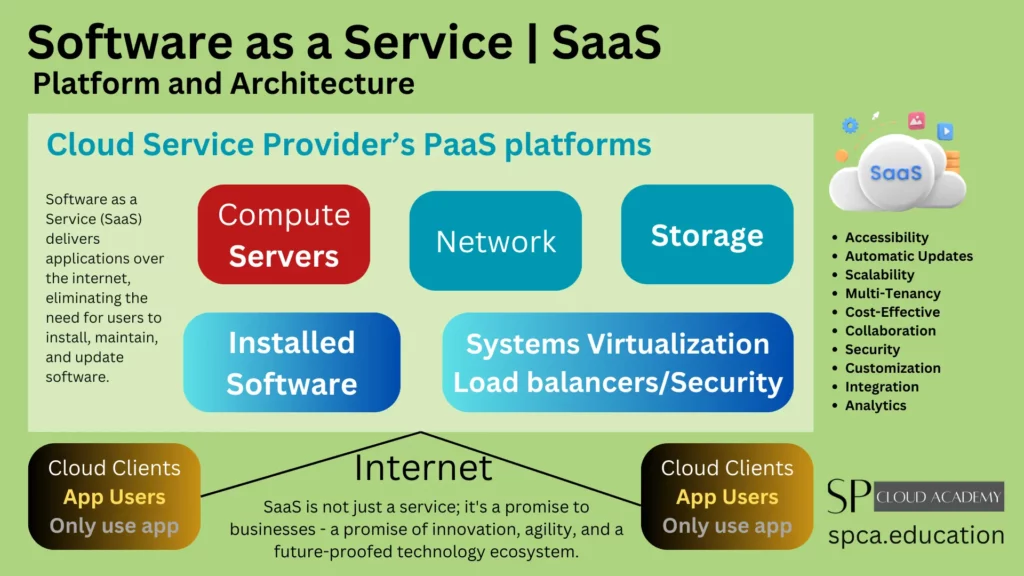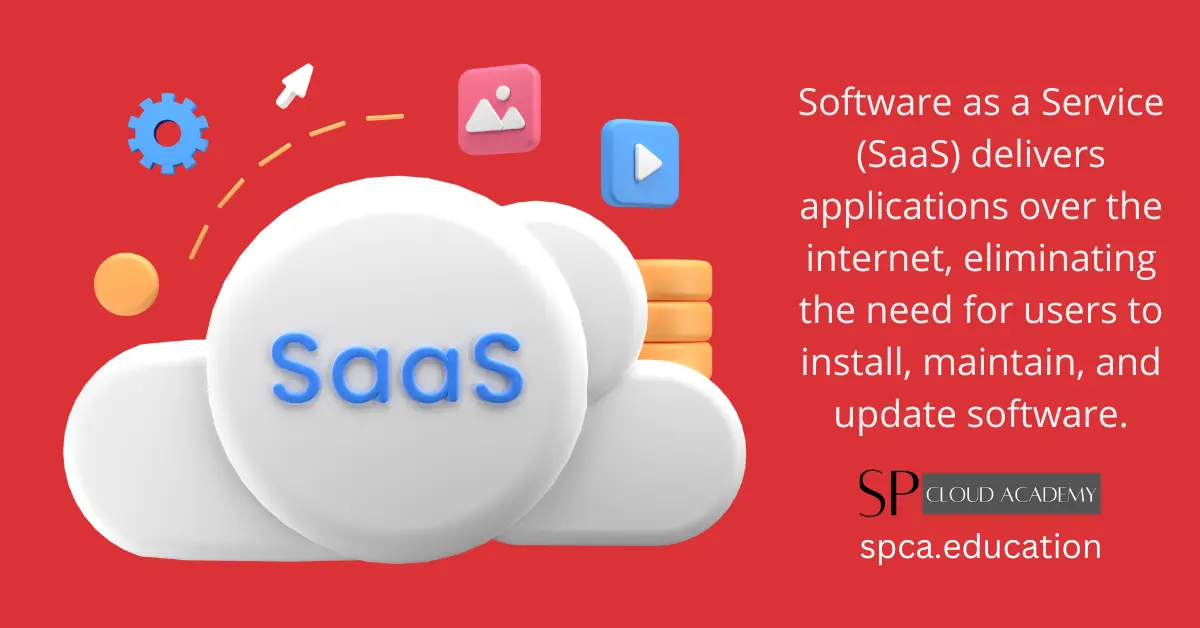In today’s fast-paced business environment, the technological landscape is constantly evolving. Among the many innovations that have reshaped the way businesses operate, cloud computing stands out as a game-changer. Within the realm of cloud computing, the Software as a Service (SaaS) model has emerged as a pivotal force driving efficiency, agility, and innovation. This article aims to provide a comprehensive exploration of the SaaS model within the context of cloud computing, unveiling its benefits, growth trajectory, key features, implementation strategies, security considerations, popular providers, training opportunities, and integration possibilities.
Understanding Cloud Computing and SaaS
Cloud computing, in its essence, refers to the delivery of computing services – including servers, storage, databases, networking, software, and more – over the internet, allowing for flexible resources and economies of scale. It eliminates the need for organizations to invest in and maintain physical infrastructure, thereby offering a more cost-effective and streamlined approach to IT operations. On the other hand, the Software as a Service (SaaS) model enables users to access and use software applications via the internet on a subscription basis. This eliminates the need for individual installation and maintenance, making software more accessible and scalable.

The symbiotic relationship between cloud computing and the SaaS model has revolutionized the way businesses leverage technology. SaaS applications are hosted in the cloud, ensuring that users can access them from any device with an internet connection, fostering collaboration and mobility. This seamless accessibility, combined with the scalability and cost-effectiveness of cloud computing, has propelled the SaaS model to the forefront of modern business operations, driving efficiency and innovation.
The evolution and widespread adoption of the SaaS model have reshaped the traditional software landscape, offering businesses a more efficient and flexible alternative to on-premises solutions. From customer relationship management (CRM) to enterprise resource planning (ERP) and beyond, SaaS applications span a wide array of business-critical functions, empowering organizations to operate with unprecedented agility and responsiveness.
Advantages of the SaaS Model
One of the primary advantages of the SaaS model lies in its cost-effectiveness. By eliminating the need for costly infrastructure and ongoing maintenance, SaaS applications significantly reduce the total cost of ownership for businesses. This subscription-based pricing model allows organizations to pay only for the features and services they use, providing a more predictable and manageable cost structure. Furthermore, SaaS applications often offer automatic updates and maintenance, ensuring that businesses always have access to the latest features and security enhancements without the need for manual intervention.
The scalability of SaaS applications is another key advantage, allowing businesses to adjust their software usage based on their changing needs and growth trajectories. As organizations expand or contract, they can easily scale their SaaS subscriptions up or down, ensuring that they always have the right level of resources without overcommitting to expensive infrastructure. Additionally, the accessibility and flexibility of SaaS applications enable employees to work from anywhere, driving productivity and collaboration while reducing geographical constraints.
The rapid deployment of SaaS applications is also a significant advantage, as businesses can quickly implement new software solutions without the lengthy installation and setup processes associated with traditional on-premises software. This agility allows organizations to respond to market demands and opportunities more swiftly, gaining a competitive edge in the process. Combined with the ability to integrate with other cloud services and third-party applications, SaaS models offer a level of adaptability and innovation that is unparalleled.
Growth of SaaS in the Cloud Computing Industry
The growth of the SaaS model within the cloud computing industry has been nothing short of remarkable. As businesses increasingly recognize the benefits of cloud-based software solutions, the demand for SaaS applications has surged. According to market research, the global SaaS market is projected to continue its rapid expansion, driven by the ongoing digital transformation efforts of businesses across various sectors.
One of the key drivers of this growth is the shift towards subscription-based models and the widespread adoption of cloud technologies. Businesses are increasingly embracing the flexibility and cost-efficiency of SaaS, leveraging a wide range of applications to streamline their operations and empower their workforce. This trend is further fueled by the proliferation of mobile devices, which has created a demand for cloud-based software that can be accessed anytime, anywhere.
Furthermore, the continuous innovation and diversification of SaaS offerings have expanded the scope of applications available, catering to an ever-widening array of business needs. From small startups to large enterprises, organizations are turning to SaaS solutions to drive digital transformation, enhance customer experiences, and achieve operational efficiency. As the SaaS market continues to mature, it is expected to become even more pervasive across industries and geographies, shaping the future of business technology.
Key Features of Cloud Computing SaaS
The key features of cloud computing SaaS are designed to deliver unparalleled convenience, efficiency, and functionality to users. Multi-tenancy, a fundamental characteristic of SaaS, allows multiple users to access a single instance of the application, ensuring cost savings and streamlined maintenance for providers. This shared infrastructure model enables providers to deliver updates and enhancements to all users simultaneously, ensuring a consistent and up-to-date user experience.
Additionally, the self-service nature of SaaS applications empowers users to customize and configure their software environment based on their unique requirements, without the need for extensive IT expertise. This user-centric approach fosters autonomy and innovation, allowing businesses to adapt their software to evolving needs and market dynamics. Furthermore, the seamless integration capabilities of SaaS applications enable organizations to connect with other cloud services and on-premises systems, creating a unified ecosystem that maximizes efficiency and data accessibility.
The accessibility and mobility afforded by cloud computing SaaS are further augmented by the robust security features that underpin these applications. SaaS providers invest heavily in ensuring the confidentiality, integrity, and availability of their users’ data, employing advanced encryption, authentication, and authorization mechanisms to safeguard sensitive information. This commitment to security and compliance standards gives businesses the confidence to embrace SaaS solutions without compromising data protection or regulatory requirements.
Implementing SaaS in Your Business
The implementation of SaaS in your business involves a strategic approach to selecting, deploying, and managing cloud-based software applications. The first step in this process is to assess your organization’s needs and objectives, identifying the areas where SaaS solutions can drive the most value. By conducting a thorough analysis of your current workflows, pain points, and growth projections, you can pinpoint the specific applications that align with your strategic priorities and operational requirements.
Once the ideal SaaS applications have been identified, the next phase involves evaluating potential providers and conducting due diligence to ensure that their offerings align with your business goals and compliance standards. This includes assessing the provider’s track record, service level agreements, data security protocols, and scalability options. It’s imperative to choose a SaaS provider that not only meets your immediate needs but also has the capacity to support your long-term growth and innovation initiatives.
The successful integration of SaaS applications into your business ecosystem hinges on effective change management and user adoption strategies. Providing comprehensive training and support to your employees is essential to maximizing the benefits of SaaS, ensuring that they can leverage the full potential of the software and embrace new workflows with confidence. Furthermore, establishing clear governance and performance metrics will help monitor the impact of SaaS implementation, enabling continuous optimization and alignment with your business objectives.
Security Considerations for SaaS
As businesses increasingly rely on cloud computing SaaS for critical operations, security considerations become paramount. When entrusting sensitive data and core business processes to third-party SaaS providers, it’s essential to thoroughly assess their security posture and compliance certifications. Look for providers that adhere to industry-specific regulations and standards, and have robust data protection measures in place.
Data encryption, access controls, and secure authentication mechanisms are foundational elements of SaaS security, safeguarding your organization’s information from unauthorized access and cyber threats. Additionally, regular security audits, vulnerability assessments, and incident response protocols should be part of your SaaS provider evaluation process, ensuring that they have a proactive and comprehensive approach to safeguarding your data.
It’s also crucial to establish clear data ownership and data residency guidelines with your SaaS provider, especially if your business operates in regions with specific data sovereignty requirements. Understanding how and where your data is stored, processed, and backed up is essential for regulatory compliance and risk management. By collaborating closely with your SaaS provider on security matters, you can establish a robust partnership that prioritizes the protection of your organization’s digital assets.
Popular Cloud Computing SaaS Providers
The landscape of cloud computing SaaS providers is diverse and dynamic, offering a multitude of specialized solutions for various industries and functions. Leading the pack is Salesforce, a global CRM platform that has redefined customer relationship management through its cloud-based SaaS offerings. Salesforce’s suite of applications spans sales, marketing, service, and commerce, empowering businesses to connect with their customers in innovative and personalized ways.
Another prominent player in the SaaS arena is Microsoft with its Office 365 suite, which delivers a comprehensive set of productivity tools, including email, collaboration, and document management applications. The integration of Office 365 with Microsoft’s cloud infrastructure ensures seamless access and mobility for users, fostering productivity and teamwork across organizations of all sizes.
For businesses seeking robust enterprise resource planning (ERP) solutions, Oracle’s suite of cloud-based SaaS applications offers a powerful array of financial management, procurement, project management, and supply chain functionalities. Oracle’s commitment to cloud innovation has positioned it as a top choice for organizations looking to modernize their core business processes and achieve operational excellence.
Beyond these industry giants, a multitude of niche SaaS providers cater to specific business needs, offering specialized applications for areas such as human resources, finance, analytics, and more. As businesses navigate the SaaS landscape, it’s crucial to evaluate providers based on their industry expertise, scalability, security, and integration capabilities to ensure that their offerings align with your strategic vision and operational imperatives.
Training and Certifications for SaaS
As businesses embrace cloud computing SaaS solutions, the need for skilled professionals who can effectively manage and optimize these applications becomes increasingly critical. Training and certifications in SaaS technologies and platforms empower IT professionals, administrators, and developers to harness the full potential of cloud-based software and drive organizational success.
Leading SaaS providers often offer comprehensive training programs and certifications that equip individuals with the knowledge and skills needed to proficiently deploy, manage, and customize their applications. These programs cover a wide spectrum of topics, including platform administration, development, integration, security, and best practices, enabling participants to become adept at leveraging the capabilities of SaaS for strategic advantage.
Moreover, industry-recognized certifications in cloud computing SaaS serve as a validation of an individual’s expertise and proficiency in specific platforms and technologies. These credentials not only enhance professional credibility but also demonstrate a commitment to continuous learning and mastery of SaaS best practices. As businesses increasingly prioritize cloud-based solutions, professionals with SaaS certifications are poised to play a pivotal role in driving digital transformation and innovation initiatives.
SaaS Integration and Customization
The integration and customization capabilities of cloud computing SaaS applications are foundational to their adaptability and value proposition for businesses. SaaS applications are designed to seamlessly connect with other cloud services, on-premises systems, and third-party applications, creating a unified ecosystem that maximizes efficiency and data accessibility. This interoperability enables organizations to leverage the strengths of different solutions while ensuring seamless data flow and process orchestration.
Customization features within SaaS applications empower businesses to tailor their software environments to specific workflows, preferences, and industry requirements without the need for extensive coding or development efforts. This user-centric approach fosters agility and innovation, allowing organizations to adapt their software to evolving needs and market dynamics. Furthermore, the flexibility to configure and extend SaaS applications through low-code or no-code tools empowers business users to drive continuous improvement and innovation within their software environment.
The successful integration and customization of SaaS applications require a strategic approach that aligns with the organization’s overarching digital transformation goals. By leveraging robust integration platforms and engaging with SaaS providers’ professional services, businesses can orchestrate seamless connections between disparate systems and ensure data consistency and integrity. Additionally, establishing clear governance and change management protocols is essential to maximize the value derived from SaaS integration and customization efforts.
Conclusion
The Software as a Service (SaaS) model within the realm of cloud computing has emerged as a transformative force, empowering businesses to achieve unparalleled agility, efficiency, and innovation. By providing subscription-based access to software applications hosted in the cloud, SaaS has redefined the way organizations leverage technology, driving cost-effectiveness, scalability, and accessibility. As businesses increasingly embrace digital transformation, the SaaS model stands at the forefront, offering a diverse array of applications that cater to critical business functions, from customer relationship management to enterprise resource planning and beyond.
The advantages of the SaaS model, including cost-effectiveness, scalability, rapid deployment, and seamless integration, have propelled its growth within the cloud computing industry. As businesses seek to implement SaaS solutions, careful consideration of security, provider selection, user adoption, and customization strategies becomes paramount. Furthermore, the availability of comprehensive training and certifications for SaaS technologies empowers professionals to harness the full potential of cloud-based software, driving organizational success and innovation.
In conclusion, the SaaS model continues to shape the future of business technology, offering a paradigm shift in software delivery and accessibility. As organizations navigate the diverse landscape of cloud computing SaaS providers, the strategic integration and customization of these applications hold the key to unlocking their full potential, enabling businesses to adapt, innovate, and thrive in an ever-evolving digital environment. With the right approach and partnerships, businesses can harness the transformative power of cloud computing SaaS, propelling themselves towards unparalleled efficiency and competitiveness in the digital era.
See also
-

Battle of the Giants: Comparing AWS, Google Cloud, and Microsoft Azure Head-to-Head
-

Cloud 2025: Game-Changing Innovations Driving the Future of Technology
-

The Ultimate Cloud Hosting Handbook: Every Feature, Benefit, and Pitfall Explained
-

From Hardware to Apps: Mastering Every Type of Virtualization in Cloud Computing
-

Unlock the Sky: 10 Must-Read Books on Cloud Computing for Every Skill Level
-

Your Cloud Migration Just Got Easier: A Step-by-Step Decision Guide
